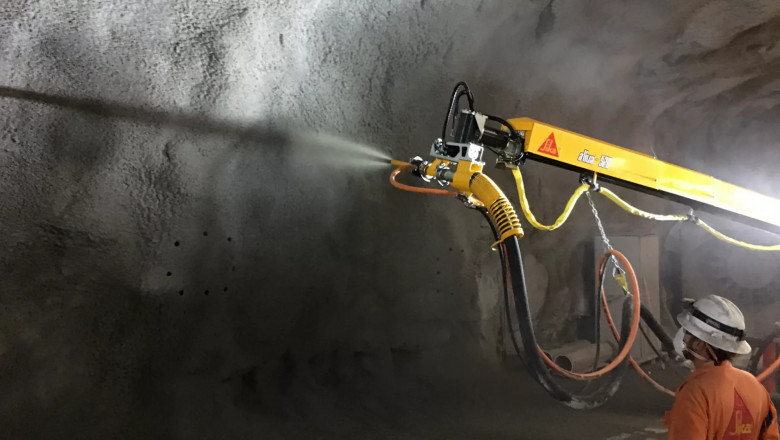views
In South Africa, where mining and construction underpin economic activity, shotcrete mining and shotcrete concrete play critical roles in ensuring safety and durability. Offered by specialists like Altecrete, these techniques involve spraying concrete at high velocity to reinforce structures—shotcrete in mining stabilizes underground excavations, while shotcrete concrete enhances construction projects. This article examines their development, technical specifications, applications, and comparative benefits in a South African context, concluding with a detailed FAQ.
Shotcrete Mining: Underground Stabilization
Historical Development
Shotcrete mining emerged in the early 20th century, pioneered by Carl Akeley in 1911 with his "cement gun" for zoo exhibits, later adapted for mining in the 1950s. In South Africa, its use expanded with the gold and platinum booms, addressing the need to secure tunnels and stopes in deep-level mines. Altecrete’s expertise reflects decades of refining this technique for the country’s rugged mining conditions.
Technical Specifications
Shotcrete in mining uses a wet or dry mix—cement, aggregates, water, and additives—sprayed via pneumatic nozzles at 20-30 meters per second. Wet-mix shotcrete, pre-mixed, offers 20-40 MPa compressive strength, applied in 50-150mm layers; dry-mix, mixed at the nozzle, suits remote sites. Equipment includes robotic sprayers or handheld guns, with Altecrete providing tailored solutions—costs vary (R500-R1500/m³), depending on mix and labor.
Applications
In South African mines, shotcrete stabilizes underground workings. In a Gauteng gold mine, Altecrete sprays 100mm of wet-mix shotcrete onto a tunnel wall—hardening in hours, it prevents rockfalls, ensuring miner safety. Its rapid application suits the fast-paced mining cycle, reducing downtime. Available through Altecrete’s services, it’s a cornerstone of structural support in the country’s deep, seismically active mines.
Shotcrete Concrete: Versatile Construction Reinforcement
Historical Development
Shotcrete concrete evolved alongside its mining counterpart, gaining traction in construction by the mid-20th century for its speed and adaptability. In South Africa, its use grew with infrastructure projects—bridges, dams, and buildings—since the 1970s, leveraging the country’s cement production strength. Altecrete’s application of shotcrete concrete reflects its role in modern construction demands.
Technical Specifications
Shotcrete concrete employs similar wet or dry mixes—cement, sand, gravel, and admixtures—sprayed at 20-30 m/s, achieving 25-50 MPa strength. Wet-mix ensures uniform consistency, applied 50-200mm thick; dry-mix allows on-site flexibility. Equipment ranges from truck-mounted pumps to portable units, with Altecrete offering mixes tailored to project specs—costs range R600-R2000/m³, factoring in additives like fibers or accelerators.
Applications
Shotcrete concrete reinforces diverse structures. In a Cape Town retaining wall, Altecrete applies 150mm of fiber-reinforced shotcrete—curing quickly, it resists erosion, supporting urban expansion. Its ability to conform to irregular surfaces suits complex builds, from pools to tunnels. Altecrete’s services deliver this versatile solution across South Africa’s construction landscape, enhancing durability efficiently.
Historical Context: Shotcrete’s South African Evolution
Shotcrete mining took root in the 1950s, adapting Akeley’s 1911 invention to South Africa’s deep mines, driven by safety needs in gold and platinum extraction. Shotcrete concrete followed, supporting 1970s infrastructure growth as urbanization accelerated. Altecrete’s role reflects a century of shotcrete refinement—meeting mining’s stability demands and construction’s versatility in a resource-rich nation.
Practical Applications: Real-World Use
In a Limpopo platinum mine, Altecrete sprays shotcrete to reinforce a stope—50mm layers halt rock bursts, protecting workers. In a Durban bridge repair, shotcrete concrete overlays 100mm—restoring strength in days, not weeks. South African examples include mine safety upgrades and rapid infrastructure fixes—both leveraging Altecrete’s expertise for fast, reliable reinforcement.
Shotcrete Mining vs. Shotcrete Concrete: Purpose and Scope
Shotcrete mining (R500-R1500/m³) stabilizes underground excavations—50-150mm layers, 20-40 MPa—for safety; it’s rapid, site-specific. Shotcrete concrete (R600-R2000/m³) reinforces surface structures—50-200mm, 25-50 MPa—for durability; it’s adaptable, project-driven. Both from Altecrete use similar tech—wet/dry mixes, spraying—but differ in context: mining for subsurface, concrete for above-ground. No licensing restricts their use in South Africa.
Implementation and Care
Shotcrete mining requires trained operators—wet-mix needs pre-mixing, dry-mix onsite water control; cure with moisture, avoid over-spray. Shotcrete concrete demands surface prep—clean, roughen—cure 7-28 days; additives enhance strength. Altecrete ensures quality—mix design, equipment calibration—for both, with no legal barriers beyond standard safety compliance in South Africa.
Conclusion: Robust Reinforcement Solutions
Shotcrete mining and shotcrete concrete from Altecrete fortify South Africa’s mining and construction sectors—R500-R2000/m³ for tailored stability and strength. Available through their expertise, these methods offer rapid, durable solutions for underground safety and surface resilience. Together, they support a nation reliant on secure mines and infrastructure.
FAQs: Shotcrete Mining and Shotcrete Concrete
How much does shotcrete mining cost?
Costs range R500-R1500/m³—e.g., R1000/m³ for a tunnel lining—site-dependent.
What’s the strength of shotcrete concrete?
It achieves 25-50 MPa—suitable for walls, bridges, and more.
How fast does shotcrete set in mining?
Wet-mix hardens in hours—dry-mix slightly longer—minimizing downtime.
What’s the cost of shotcrete concrete?
Ranges R600-R2000/m³—e.g., R1200/m³ with fibers—project-specific.
Can shotcrete be used above and below ground?
Yes—mining for tunnels, concrete for surface builds—versatile application.
How thick is shotcrete applied?
Mining uses 50-150mm; concrete 50-200mm—adjusted per need.














Comments
0 comment